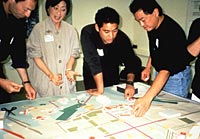|
|
"Affordable housing development is a complex process with many variables. Understanding how design fits into this process - especially the critical decision points and when they occur - will help development organizations see how to use quality design to bring together and resolve many of the variables. Moreover, design itself is a process that has to be managed. Understanding how to coordinate the steps in, and the actors around, design is critical. The result will be better developments that strive for and achieve the highest levels of design excellence."
Joe McNeely,
Development Training Institute,
Baltimore, MD
Tools for Step 3
Print Step 3
|
|
|
Step 3. Understand where design fits in the development timeline
Why is this step important?
Timing is everything. As a developer you are responsible for every aspect of an affordable housing project, from financing and regulatory approval to construction and occupancy. Design quality is only one of your concerns - an important one, but one that is often overwhelmed by more pressing issues. To make sure that design quality is not lost over the course of a project, it is necessary to understand:
- how the design process unfolds,
- where specific design phases fit in the overall development timeline, and
- when specific steps should be taken to ensure that design quality is "built in" to the project.
When should this step be done?
During the Concept phase of development.
Who should do this step?
What should be done?
- Review the Design/Development Matrix for a summary of how the basic phases of affordable housing development relate to the basic phases of architectural design.
- Pay special attention to the specific steps that are recommended at each phase and when they should occur to have the most impact on design quality.
- Review the definitions used for the various design and development phases listed on the matrix. Design Phase Definitions
- Refer back to the individual descriptions of the 20 Steps to Design Quality listed on the matrix.
- Recognize that the development process will vary from project to project and the sequence of design and development activities may also vary. However, the basic ideas and terminology you find here will most likely be the same. The matrix is a typical example of the process, based on standard architectural language and experiences from a wide range of developments.
- Print the Design Development Matrix and add it to the Project Book.
How can doing this help move my project forward?
- A clear understanding of the phases and the "language" of design will foster better communication between all members of the design and development team.
- An understanding of how the phases of design relate to the overall development timeline will help optimize overall project scheduling and avoid duplication and overlap.
- Finally, an understanding of when the Design Advisor's 20 Steps to Design Quality should occur will ensure that these steps are indeed taken and not overlooked as the design/development process proceeds.
Additional Resources:
|
